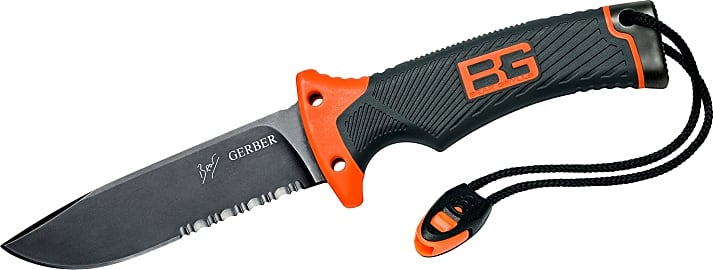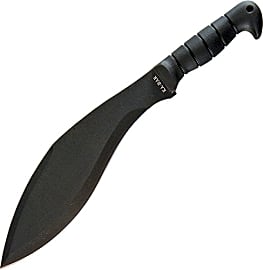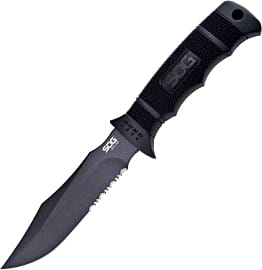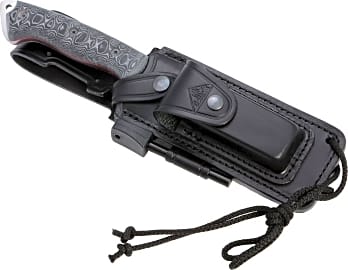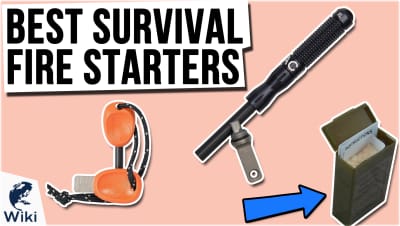The 10 Best Survival Knives

This wiki has been updated 39 times since it was first published in September of 2015. Survival knives are must-have gear for campers, hikers, hunters, and military personnel. Depending on the model, they may be equipped with sharpeners, fire starters, whistles, and more, allowing you to carry a veritable arsenal of tools in a compact and lightweight package that won't slow you down. All of our choices have fixed blades to ensure durability in the field. When users buy our independently chosen editorial picks, we may earn commissions to help fund the Wiki.
Editor's Notes
December 03, 2019:
When it comes to survival knives, there are a few features that we consider non-negotiable. These include a full-tang, a fixed blade, carbon or stainless steel construction, and a minimum blade length of four inches. They should also be hefty enough to chop wood and easy enough to control for precision jobs.
Based on those factors, we had to eliminate the BlizeTec 5-in-1 due to its folding design, since that is just one more point of potential failure when in the field. We also removed the MT Knives Genesis EDC because we felt its small blade length didn't offer enough versatility. Additionally, we decided to get rid of the Gerber Prodigy and BlizeTec BT985LE, not because they violated any of our parameters, but rather because we simply felt there were better options.
One of these better options and a new addition to our list is the Benchmade Arvensis 119, which features a partially-serrated blade that allows it to be used for sawing or slicing. It is also coated for corrosion resistance and comes with the company's lifetime warranty. Another item making its debut on our list is the Ka-Bar KBAR1217. One of the most iconic blades in the world, this knife has been a staple survival tool and weapon of the U.S. Marines since World War II, and if it is good enough for their needs, it should definitely stand up to anything you throw at it. We also included the Ka-Bar Kukri 2-1249-9 from the same manufacturer. Though large and heavy, it is surprisingly versatile.
For those whose survival may depend on keeping warm, we have included the Morakniv Bushcraft M-11742, Gerber Bear Grylls Ultimate, and CDS-Survival Celtibero Black, all of which come with a fire starter.
Special Honors
Tops Knives Alaskan Harpoon AH906 With a 6.75-inch blade and an overall length of 12 inches, this knife is ready for some heavy-duty tasks. It features a nearly unbreakable black linen micarta handle and a rust-resistant coating that also prevents it from reflecting light. topsknives.com
Smith & Sons Tataille Whether skinning, chopping, or clearing brush, the Tataille is well-suited to the task. Though it has a thick blade, the flat grind helps to compensate for that so it still slices easily. This also makes it simple to sharpen, especially for those inexperienced with the process. smithandsonsknives.com
Why You Need A Survival Knife
The blades are usually fairly long and extremely sharp, so you can use them as weapons if you have no other choice.
There are certain things you just wouldn't think about leaving behind when you venture into the Great Outdoors — things like water, a fire starter, and your compass.
You should go ahead and add a survival knife to that list, as well.
There's a reason why they're called "survival" knives, after all, as having one can literally save your life if things get hairy. The blades are usually fairly long and extremely sharp, so you can use them as weapons if you have no other choice. This is a last-resort, of course, as you're much better running away from danger than you are stabbing and slicing at it.
Having a roaring fire going is one of the most important tasks you'll have when camping — and having a survival knife makes starting that fire even easier. You can use it like an ax, enabling you to chop kindling, or strike a flint against it to make sparks.
If you like to hunt while you're out there, you can tie your knife to a long stick and use it as a spear, and it can make short work of skinning your dinner. Or, if you just like to eat the food you brought with you, it can double as a can opener.
Most knives have a large base that you can use as a hammer when you're putting a tent together or cracking nuts. Leave it in the sheath when you're hammering with it, though — nothing can ruin a camping trip faster than massive blood loss.
And while it's not ideal for digging, it can be used for it. That comes in handy if you're looking for worms to use as bait, roots that might be edible, or if you need a hole to use as a bathroom.
Don't think it's only useful at the campsite, either — it's also fantastic for getting you there. You can slice a trail through thick brush and dense forest, opening up parts of the wilderness that might otherwise have been closed off to you.
Most importantly, however, wielding a large knife is essential if you want to pretend to be Rambo while no one's watching.
Choosing The Right Survival Knife
Now that you know that you should have a trusty knife by your side the next time you venture into the wilderness, there's the little matter of finding the right one.
The first thing you should do is consider what, exactly, you'll need it for. Then, once you've got a good idea of what jobs you'll need this knife to accomplish, you can start shopping.
Of course, when you're stuck in a bad situation far away from help, any knife is better than no knife.
There are two basic kinds of knives: fixed-blade and foldable, each of which comes in a variety of sizes. Large fixed-blade knives, like machetes, are fantastic for hacking and chopping, while smaller ones are good for doing more detailed work.
Foldable knives are usually smaller and easier to carry, and many have other tools besides just a blade (think Swiss Army knife).
For most regular campers, a foldable knife will be all that they need. Serious survivalists, on the other hand, will eventually need a fixed-blade knife — a couple of them, in fact, and a foldable one. Nobody said staying alive would be cheap.
Consider the weight of the knife before you buy, as well. Heavier models are usually more durable, and they're great for using as a hammer if necessary. The downside, of course, is that they're, well, heavy.
The last thing to consider is the blade material. Most options use stainless steel, which is inexpensive — but the blade will lose its edge quickly. That's fine if you're okay with sharpening it, or if you don't plan on using it all that much, but people whose lives depend on their knives will be better off going for a costlier carbon steel blade.
Of course, when you're stuck in a bad situation far away from help, any knife is better than no knife.
Other Gear You Might (Literally) Not Be Able To Live Without
Deciding how much survival gear you need requires a delicate balance. There's a ton of gear that you could possibly need if things go wrong, but if you carried it all with you, you'd need to take a couple of pack mules along.
The main question you need to ask yourself is what you'd need to survive long enough for help to arrive. These needs can basically be broken down into first-aid gear, food and water, fire and shelter, and a way to contact rescue personnel.
Once you have the essential gear, you can fearlessly venture out into the wilderness — and you won't have to worry about throwing your back out in the process.
Unless you're a surgeon capable of performing complicated operations in the middle of the wilderness, a basic first-aid kit is probably fine.
Water is the most important thing you'll need — and also the heaviest, so it's best to just have a canteen or bottle, as well as a way to filter any sources you come across. Food is less essential, so having some jerky or other non-perishable items should be plenty to keep you alive.
Fire and shelter are next on the list of importance. You can carry a tent with you, or use your knife to build a shelter. You can try to find a cave — but you never know who else will have the same idea. Likewise, carry some means of starting a fire, and keep some dry kindling in a Ziploc bag, just in case.
Finally, have something that will let you alert rescue personnel to your presence. This can be a loud whistle, a mirror you can use to reflect light, or a signal flare (although be wary of starting a fire you can't escape with that last one).
Once you have the essential gear, you can fearlessly venture out into the wilderness — and you won't have to worry about throwing your back out in the process.





